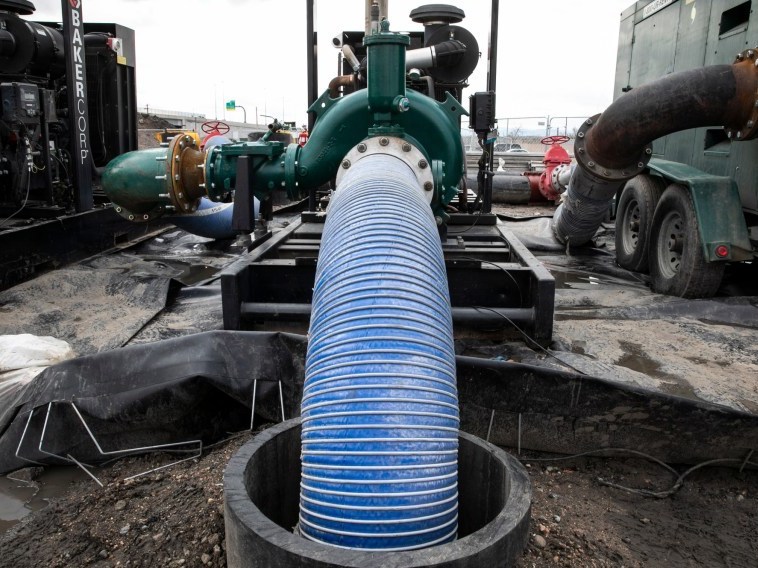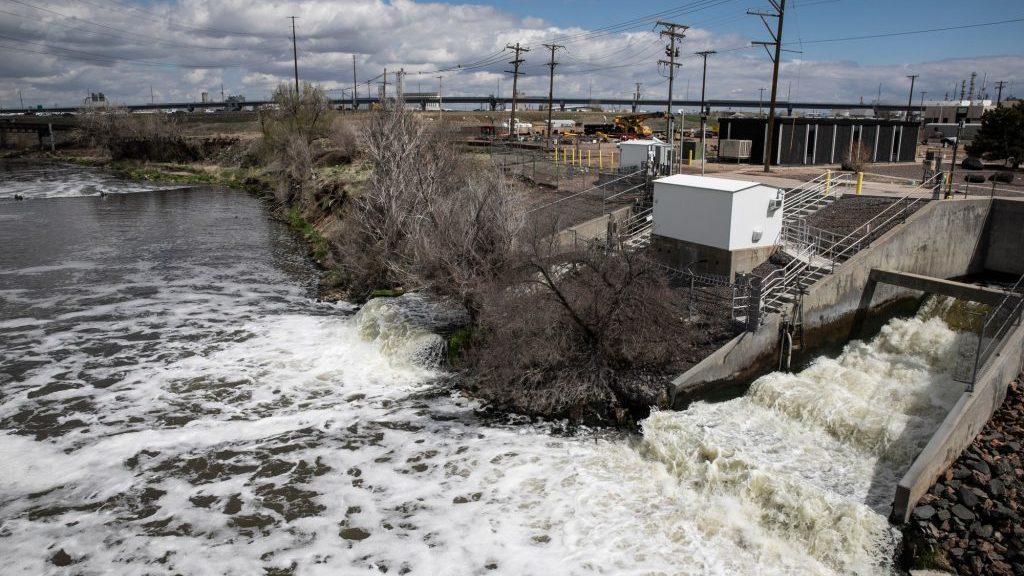
How Your Hot Showers And Toilet Flushes Can Help The Climate
LISTEN
BY SAM BRASCH
A secret cache of clean energy is lurking in sewers, and there are growing efforts to put it to work in the battle against climate change.
The U.S. Department of Energy estimates Americans wash enough energy down the drain every year to power about 30 million homes. The sources are often everyday items inside homes. Think hot showers, washing machines and sinks. Evolving technology is making it easier to harness that mostly warm water.
Denver is now constructing what is likely the largest sewer heat-recovery project in North America, according to Enwave, a Canadian energy company set to operate the system.

Treated Denver wastewater flows into the South Platte River in April. In what may be the largest U.S. project of its kind, Denver will use excess energy from sewage wastewater to heat and cool a new agriculture, arts and education center.
CREDIT: Hart Van Denburg/CPR News
Over the next few years, a $1 billion remodel will turn the 250-acre site, home to the National Western Stock Show and Rodeo, into a hub for art, education and agriculture. The revamped National Western Center will include about a million square feet of new indoor space, all of which will be heated and cooled with energy from the sewer pipes below.
Brad Buchanan, the CEO leading the redevelopment, said the project has already changed how he thinks about the best location for real estate. Big pieces of sewer infrastructure have long repelled development. Now he imagines they might be sought out as a way to save energy costs and avoid greenhouse gas emissions.
The National Western Center estimates the project will help it annually avoid the carbon equivalent of driving an average gas-powered car around the equator 250 times.
“It’ll be interesting to see if folks start to look at not just where light rail lines or good schools are located, but what’s the proximity to a large sanitary sewer line,” Buchanan said.
How to mine for sewer heat
The technology to harvest sewer heat isn’t complicated.
At the National Western Center, construction crews have already completed a pit exposing the main sewer line. The wastewater inside stays a mild 55 to 75 degrees year-round, local officials say, no matter the weather outside. That consistent temperature can be tapped to heat and cool aboveground buildings.
The key is a massive heat pump, which will be housed in a central plant on the campus. The device works like a reversible air conditioning unit. In the winter, it will transfer energy from the sewage into a clean-water loop connecting the buildings, adding heat to indoor spaces. The process can then be flipped to keep things cool in the summer.
And to answer an obvious question: No, the raw effluent is never exposed to the air, so people occupying the buildings won’t get hit with waves of sewer stink.
Shanti Pless, a research engineer with the National Renewable Energy Laboratory in Golden, Colo., said the technology opens up a vast world of “renewable heat mining.”
“With the advent of large-scale heat pumps, we can cost-effectively use, say, 70-degree wastewater to heat our buildings and our hot-water systems,” Pless said.
Rethinking how we heat and cool buildings
Pless said the biggest barrier isn’t technology — it’s helping developers rethink the size of their heating and cooling systems. Sewer heat recovery often works best as the heart of a district-size energy system, where a central plant provides energy to a whole neighborhood or office complex.

The National Western Center negotiated rights “in perpetuity” to the thermal energy from sewers under its construction site. It expects to save energy costs and avoid climate-warming emissions.
CREDIT: Hart Van Denburg/CPR News
Denver itself shows how this kind of centralized strategy has fallen out of favor in the United States.
A 141-year-old steam heat system warms many of the city’s downtown buildings, supplying energy from a central gas plant operated by Xcel Energy. As costs to improve the system have landed on customers, many building operators have disconnected from the steam service in favor of smaller, independent heating and cooling systems.
Nevertheless, Pless said district energy often makes sense, but it requires a careful study of the energy needs and resources in a specific area. NREL has developed tools to help communities model the viability of heat-recovery systems. He said the National Western Center could also help blaze a trail into the sewers.
“This has been a great local example for us to take the idea to the rest of the country,” Pless said.
A sewer energy gold rush?
If sewer energy catches on, one reason could be the potential benefits for wastewater districts.
That’s because warm sewage causes its own environmental problems. In Denver, wastewater is often hotter than the South Platte River, its final destination after running through a treatment plant. This “thermal pollution” can imperil native plants and wildlife.
Mickey Conway, Metro Wastewater district manager, said it’d be possible to build cooling towers to chill the treated sewage, but the National Western Center project could showcase a better alternative. New homes and buildings could harvest this heat, cooling the water while avoiding climate-warming emissions and potentially reducing energy bills.
“It’s kind of a perfect storm of win-win situations,” Conway said.
Metro Wastewater has produced slick brochures to entice other developers with sewer heat. Conway said there are no solid plans just yet, but the district has had “discussions with Denver and Thornton,” a metro Denver suburb.
Meanwhile, the National Western Center has moved to protect its supply in the event of a kind of sewer-heat gold rush. The City and County of Denver, a partner in the project, exercised a three-year option for exclusive access to the energy inside the pipelines running through the campus.
Buchanan, the project CEO, said it amounts to a new sort of environmental resource. Instead of mineral rights or water rights, his development holds sewer thermal energy rights.
“We have it protected because we’re counting on that energy in perpetuity,” he said.
9(MDAyOTk4OTc0MDEyNzcxNDIzMTZjM2E3Zg004))















